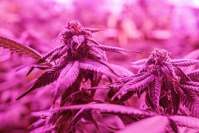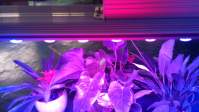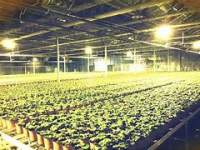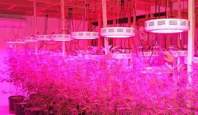Full-spectrum led plant light is the sun in the plant factory
Is there "sunlight" in the plant factory? have! Where does "sunshine" come from? It comes from some dedicated full-spectrum led plant lighting!
The plant lamps initially used in plant factories include traditional lamps such as incandescent lamps, high-pressure sodium lamps, metal halide lamps, and fluorescent lamps. At present, the most popular plant light sources are LED light sources. Since the birth of the LED light source, because of its significant innate advantages, it has quickly been favored by scientific researchers and become an efficient production tool. Shenzhen, China LED plant lights are wholesale and customized.
There is an essential difference between the LED plant growth supplement light source and the traditional lamps in the light-emitting principle. The incandescent lamp heats the filament, and when the temperature of the filament reaches a certain level, it emits light like a red soldering iron. Therefore, the incandescent lamp converts most of the electric energy into heat energy, and only a very small amount of electric energy is converted into light energy. High-pressure sodium lamps, metal halide lamps, fluorescent lamps, etc. are all gas discharge lamps. The external electric field and electrons in the rapid discharge tube excite the gas (including some gaseous metals) to discharge and cause the atom to emit light. Its spectral characteristics are mainly determined by the gas composition itself. To determine the characteristics. However, the LED grow light is a solid-state light source, and its core is a PN junction made of semiconductors. P-type semiconductors (containing a higher concentration of holes) and N-type semiconductors (containing a higher concentration of free electrons) are usually made of different semiconductor compounds, and the space charge region formed at their junction is called a PN junction. Light is emitted through the migration and recombination of electrons and holes in the PN junction. Different compounds used to make PN junctions have different light-emitting properties.
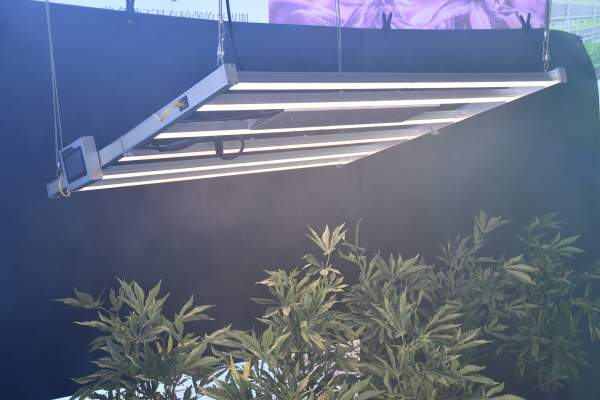
Commonly used LED packaging forms for plant lights
(1) High-power LED packaging (2) Small and medium-power LED packaging
So what are the inherent advantages of LED plant lights?
First of all, LED plant lighting is highly efficient and energy-saving. After LED plant lamps are used in agriculture, the density of lamps used is extremely high compared to general lighting, especially for plants with high light demand, the electricity consumption per square meter of planting area is as high as 500-1000 W. This puts forward strict requirements on the electro-optical conversion efficiency of led plant lights. At present, the electro-optical conversion efficiency of LED plant lights is more than 20 times that of incandescent lamps, 3 times that of fluorescent lamps, and nearly 2 times that of high-pressure sodium lamps. Therefore, the application of LED plant lights can greatly reduce power consumption, thereby achieving energy saving.
Plant factory lighting type
Second, LED plant lights have a long life, low light decay, and high reliability. The theoretical life of LED is as high as more than 100,000 hours. If the design of the LED plant light can control the working temperature of the LED under the appropriate temperature, the life of the LED plant light can exceed 50,000 hours. At present, high-end LED plant lights have a 5-year warranty, and the light decay after 36,000 hours of operation is still less than 10%. The fluorescent lamp usually has a light decay as high as 30% after 10,000 to 15,000 hours of operation.
Third, LED plant lights are highly controllable and have great potential for intelligent control. Traditional lamps, such as high-pressure sodium lamps, require more than 5 minutes to reach a stable working state from when the lamp is powered on, and it takes about 10 minutes to cool down after a power failure before starting again. The response speed of the LED is extremely high, and it can still work normally under fast switching conditions of 30,000 times per second.
Fourth, the use safety is very high, and the transportation reliability is very high. Traditional lamps are mostly made of glass, and it is inevitable that the glass will be broken and damaged during transportation and use. The LED is a solid light source, which is highly resistant to vibration, drop, impact, etc., and is safe and reliable.
Fifth, the forms of lamps are diversified. The traditional light source is generally a bulb type. When a plant lamp is manufactured, a reflector is often added to allow the light to shine downward on the target plant. The LED plant light can not only be made into a top light that emits downward light, but also can be made into an inter-plant light that emits 360 degrees close to the plant. Unlike the 360-degree light-emitting of traditional light bulbs, LED encapsulation is generally 180-degree single-sided light. It is easier to obtain a small-angle light-emitting lamp, which becomes a spotlight that focuses light on plants. It can also be manufactured into Panel-type plant lights with even light even when irradiated at close range.
Luminous wavelength distribution of LED chips with different semiconductor compounds
Sixth, the LED spectrum has a wide coverage range, and it is easy to obtain monochromatic light and full spectrum. Currently, LEDs can cover the wavelength range of 200-950 nm, and there are dozens of monochromatic LEDs. In addition, the monochromatic LED chip can excite phosphors to broaden the half-wavelength of monochromatic light, or monochromatic light composite spectrum, or obtain full-spectrum white light. This provides very favorable experimental conditions for studying the absorption of light by different plants, and realizes the customization of the spectrum of different plants, and provides the best light formula for plants.
Monochromatic LED chip excites the spectral changes of different phosphors
Seventh, the intensity and spectrum of the LED plant light can be adjusted. LED is a current-driven light source, and its brightness increases with the increase of current. Therefore, the output current of the power supply that drives the LED is adjusted to obtain the corresponding brightness. Separately control the currents of LEDs of different light colors to achieve the function of spectrum adjustable. At present, the adjustable spectrum led plant lights on the market are mainly used for scientific research, and the adjustable light intensity led plant lights have been widely used in production.
Eighth, LED plant lights generate less heat and can be in close contact with plants without causing problems such as plant leaves and operators burning. The rapid development of indoor multi-layer planting technology is also mainly due to this feature of LED plant lights.
Due to its unique advantages, the Shenzhen Yaorong Technology led plant light factory in Shenzhen, Guangdong, China, has rapidly developed the application of LED plant lights in agriculture in recent years. At present, compared with traditional lamps, the cost of LED plant lights is still higher, but with the technological advancement of the times, the cost of plant lights will definitely decrease rapidly. In the future, LED plant lights will create a broader world for agricultural production.


